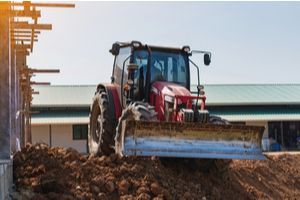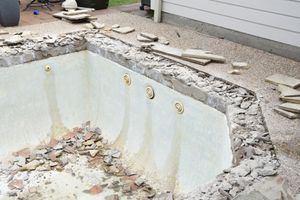An inground pool can be a lot of fun for the right family, but it also requires a lot of maintenance and expenses to keep it clean and safe. If you have reached the point where your pool is more of a burden than an asset, you may be wondering about pool removal options.
A full pool removal is the best way to restore the yard so it can be used for other purposes, but budgetary concerns lead many homeowners to seek alternative approaches. Some people choose to fill in their inground pool rather than removing it completely. Here is a closer look at what is involved in the process and how you can choose the best method for you.
What Is A Pool Fill-In?

A pool fill-in, also known as a partial pool removal, can be thought of as a quicker way of getting rid of an unwanted pool. In a traditional full pool removal, the pool’s entire shell is broken down, and then the debris hauled away before the space is filled in and finished.
With a fill-in, however, only the top part of the shell is broken down. This rubble is placed in what remains of the shell and then covered with dirt. This represents an easier and more affordable way for homeowners to reclaim their yard for another use. Here is a look at the steps involved in a pool fill-in.
Draining The Pool
First, the pool’s drain is opened so all the water can empty out of it. This must be carried out carefully so that the pool water does not drain into storm drains. Pool removal companies can handle this step in a manner that is safe, legal and eco-friendly.
Removing The Accessories
All of the lights, ladders and accessories such as diving boards will then be removed from the pool. If it is surrounded by a deck, the deck must also be partially removed to provide access to the pool’s shell.
Demolishing The Shell

A pool fill-in does not require as much demolition and hauling as a full pool removal, but there is still some demolition involved in breaking up some of the pool’s concrete. This is the most dangerous step in the process and is best left in the hands of professionals.
First, holes are drilled into the bottom of the pool with a jackhammer to prevent rainwater, snow and other moisture from collecting at the bottom of the pool. The typical spacing for these holes is one every four feet.
The jackhammer is then used to remove the top edge of the pool. The part of the pool’s edge that sits above ground level will be completely broken off and placed inside the shell.
Filling The Pool Cavity
The pool will usually be filled with enough gravel to reach the halfway point. Because a significant quantity of gravel is needed, it may be brought in by truck and dumped directly into the shell if it is accessible. A hardy gravel base allows water to travel down to the drain placed in the bottom, thereby avoiding backups and flooding in the yard.
On top of the gravel, a layer of clean filler sand will be placed extending up to about two feet below the top of the pool.
Placing The Topsoil
Finally, topsoil is added, going from the top of the layer of clean fill or sand to the top of the pool itself. Topsoil is the material of choice because it will allow for grass and vegetation to grow across the area where the pool existed to provide the yard with a natural and even appearance. The new topsoil layer is often placed a few inches higher than the lawn’s existing grade to allow it room to settle over time and avoid developing a low spot in the lawn.
At this point, the yard can be used however the homeowner wishes. Some people may choose to enjoy having a larger yard for children or pets to run around and play, while others might want to build a deck or patio for entertaining. Another common use of reclaimed pool space is a vegetable or flower garden.
Considerations When Filling In An Inground Pool

A pool fill-in can provide substantial cost savings over having a full pool removal, and it is also considerably quicker. In fact, a pool removal contractor can usually have a partial pool removal completed in one to three days. This means homeowners can begin using their yard for another purpose very quickly.
However, it is important to keep in mind that there are a few drawbacks to using this method. The biggest one is the fact that the area where a partial pool removal was carried out cannot legally be built on in the future. Although homeowners may place smaller structures there, it is not considered suitable for construction.
The fact that a pool was partially removed must also be disclosed to future buyers, which is not the case for those who opt for a full pool removal. This can reduce the home’s resale value because it restricts how the yard can be used.
Another potential issue is the possibility of pooling occurring underground and the risk of developing sinkholes in the yard. Professional pool removal contractors are experienced in preventing these types of problems, but for people who are carrying out a DIY pool fill-in, it is a significant risk to consider.
With these considerations in mind, a pool fill-in is a good option for homeowners who are on a tight budget, are eager to reclaim yard space and do not plan to sell their home in the near future. It allows you to eliminate the ongoing expenses of pool maintenance and the hazards of having a pool in a home with children, elderly people or pets who could fall inside.
Find Out More About Pool Removal
If you have decided that your inground pool is no longer serving you, get in touch with the experienced Northern Virginia pool removal contractors at Dirt Connections today to discuss the best approach for your home.
Summary

Dirt Connections was started with one goal in mind: providing quality residential and commercial construction services to clients on time and on budget. Reach out for more information on how we can support your next project.
For your convenience our estimates are free and by appointment. Call 703-940-9949 for a free estimate today!









































